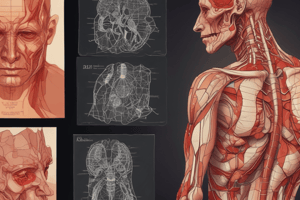Podcast
Questions and Answers
What is the outermost layer of the skin responsible for?
What is the outermost layer of the skin responsible for?
- Protecting the body from external factors (correct)
- Regulating body temperature
- Aiding in the production of vitamin D
- Removing waste products through sweat
What type of skin is characterized by a lack of moisture, often leading to itchiness and irritation?
What type of skin is characterized by a lack of moisture, often leading to itchiness and irritation?
- Dry skin (correct)
- Combination skin
- Normal skin
- Oily skin
What is the function of the skin that allows for the sensation of touch, pressure, and pain?
What is the function of the skin that allows for the sensation of touch, pressure, and pain?
- Sensation (correct)
- Excretion
- Protection
- Regulation
What is the term for the innermost layer of the skin that attaches the skin to underlying bones and muscles?
What is the term for the innermost layer of the skin that attaches the skin to underlying bones and muscles?
What is the chronic autoimmune condition characterized by thick, scaly, and red patches on the skin?
What is the chronic autoimmune condition characterized by thick, scaly, and red patches on the skin?
What is the type of skin that is a mix of dry and oily skin, with oily areas typically on the forehead, nose, and chin?
What is the type of skin that is a mix of dry and oily skin, with oily areas typically on the forehead, nose, and chin?
Flashcards are hidden until you start studying
Study Notes
Structure of the Skin
- The skin is composed of three main layers:
- Epidermis: outermost layer, responsible for protecting the body from external factors
- Dermis: middle layer, contains blood vessels, nerve endings, and hair follicles
- Hypodermis: innermost layer, attaches the skin to underlying bones and muscles
Functions of the Skin
- Protection: shields the body from external factors such as temperature, moisture, and UV radiation
- Regulation: helps regulate body temperature, maintain fluid balance, and aid in the production of vitamin D
- Sensation: contains nerve endings that allow for the sensation of touch, pressure, and pain
- Excretion: helps remove waste products through sweat
Skin Types
- Normal skin: balanced skin with a smooth texture and a moderate level of moisture
- Dry skin: characterized by a lack of moisture, often leading to itchiness and irritation
- Oily skin: characterized by an overproduction of sebum, often leading to acne and greasiness
- Combination skin: a mix of dry and oily skin, with oily areas typically on the forehead, nose, and chin
- Sensitive skin: easily irritated by products or environmental factors
Skin Conditions
- Acne: a condition characterized by blackheads, whiteheads, and inflamed pimples
- Eczema: a chronic inflammatory condition characterized by dry, itchy, and scaly skin
- Psoriasis: a chronic autoimmune condition characterized by thick, scaly, and red patches on the skin
- Skin cancer: a range of cancers that affect the skin, including melanoma, basal cell carcinoma, and squamous cell carcinoma
Studying That Suits You
Use AI to generate personalized quizzes and flashcards to suit your learning preferences.




